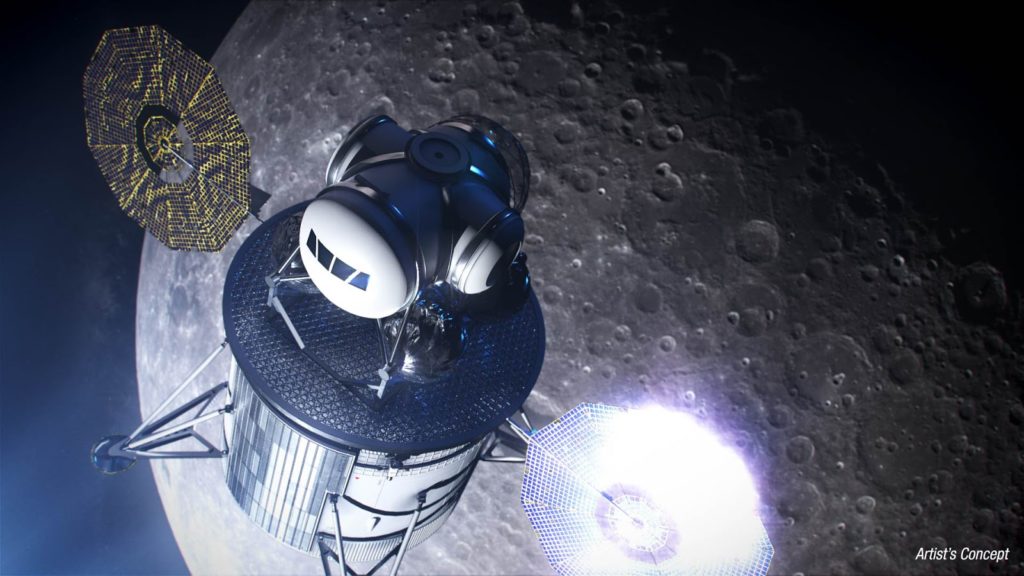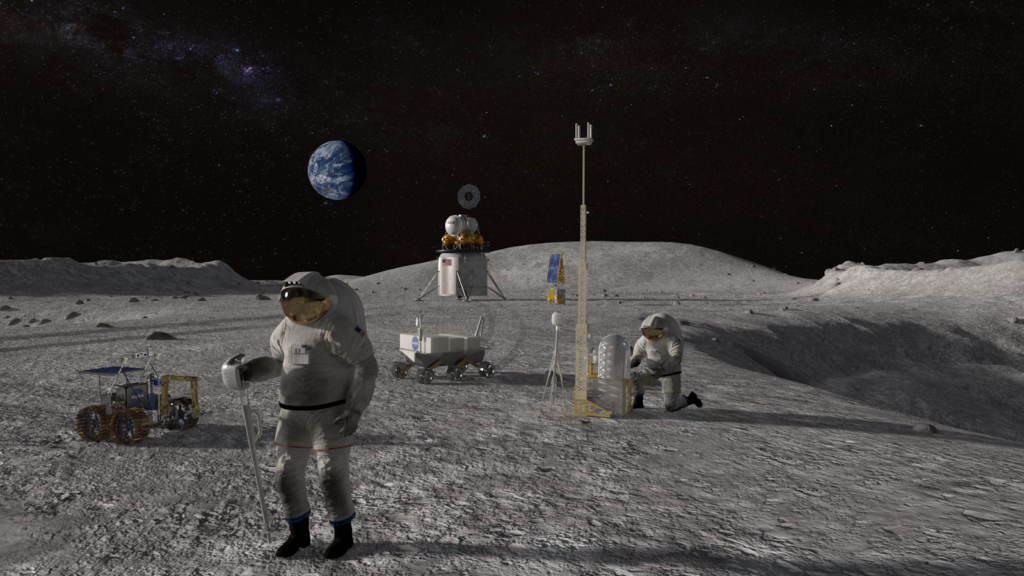 |
|
Illustration of a human
landing system for NASA’s Artemis lunar exploration program.. Credits: NASA |
May 2019
CAPE
CANAVERAL, FL – NASA has awarded new contracts
to jumpstart studies and develop prototypes for its newly named Project Artemis human lunar
exploration program to 11 firms across eight states aimed at landing American
astronauts on the Moon’s south pole
by 2024, the agency announced Thursday, May 16.
These contract award actions follow closely on
the heels of the announcement earlier this week by NASA Administrator Jim
Bridenstine on May 13 that the Trump Administration
will add an additional $1.6 Billion to NASA’s Fiscal Year 2020 budget request in
order to carry out the President’s new mandate to achieve an American human lunar
landing by 2024 – on an ambitious and accelerated timeline four years earlier
than the prior target date of 2028.
To accomplish an American lunar landing in
just 5 years by 2024 with “the first woman and the next man” NASA is vastly accelerating
the way it traditionally does business.
The 11 selected companies will be given a total of
$45.5 million to carry out studies and/or develop prototypes during the next six
months “for the descent, transfer, and refueling elements of a potential human
landing system.”
NASA has no choice but to move at ‘warp speed’
given the vagaries and uncertainties of American political culture especially given
that the next Presidential election is just 18 months away – and the whole
program could be upended if substantial technical progress towards developing a
human lunar lander is not forthcoming rapidly!
As part of the study contracts awarded under the
NextSTEP public/private partnership program NASA is also requiring the
companies to contribute at least 20% of the total project cost – to help reduce
costs to taxpayers and encourage early private investments in the lunar economy.
“We will streamline everything from procurement
to partnerships to hardware development and even operations,” said Marshall
Smith, director for human lunar exploration programs at NASA Headquarters, in a
statement.
“Our team is excited to get back to the Moon
quickly as possible, and our public/private partnerships to study human landing
systems are an important step in that process.”
The Artemis awardees, from eight states across
the country, are:
Aerojet Rocketdyne –
Canoga Park, California
Blue Origin – Kent,
Washington
study, and one transfer vehicle prototype
Boeing – Houston
prototypes, one transfer vehicle study, one transfer vehicle prototype, one
refueling element study, and one refueling element prototype
Dynetics – Huntsville,
Alabama
element prototypes
Lockheed Martin –
Littleton, Colorado
prototypes, one transfer vehicle study, and one refueling element study
Masten Space Systems –
Mojave, California
Northrop Grumman
Innovation Systems – Dulles, Virginia
prototypes, one refueling element study, and one refueling element prototype
OrbitBeyond – Edison,
New Jersey
Sierra Nevada
Corporation, Louisville, Colorado, and Madison, Wisconsin
prototype, one transfer vehicle study, one transfer vehicle prototype, and one
refueling element study
SpaceX – Hawthorne,
California
SSL – Palo Alto,
California
element prototype
The additional money is a ‘down payment” on
starting development of a lunar lander which would include three elements: a
transfer vehicle to low lunar orbit, a decent vehicle to and on the Moon and an
ascent vehicle for astronauts to return to the “Gateway” platform in lunar orbit.
The lunar lander elements will be launched on
commercial rockets.
“This additional investment, I want to be
clear, is a down payment on NASA’s efforts to land humans on the moon by 2024,”
Bridenstine elaborated during a media teleconference Monday, May 13, regarding
the Trump Administration amended NASA FY 2020 Budget request.
“This budget includes $1 billion to enable
NASA to begin supporting the development of commercial human lunar landing
systems three years earlier than previously envisioned to bring humans to the
Moon’s surface by 2024.”
“In the coming years, we will need additional
funds. But this is a good amount that gets us out of the gate in a very strong
fashion and sets us up for the future.”
NASA is developing the Orion Crew Capsule and
SLS megarocket to launch American astronauts to the Moon.
President Trump also confirmed his Administration’s
support for Project Artemis via twitter:
Administration, we are restoring @NASA to greatness and we are going back to
the Moon, then Mars. I am updating my budget to include an additional $1.6
billion so that we can return to Space in a BIG WAY!” President Trump tweeted.
The goal is to land a two person crew including
the next American man and the first American woman at the lunar south pole by
2024 within 5 years – as outlined just 6 weeks ago in a March
26 speech by Vice President Mike Pence at the fifth meeting of the National Space Council in
Huntsville, Alabama.
“The President has challenged NASA to land the
first American woman and next American man at the South Pole of the Moon by
2024, followed by a sustained presence on the Moon by 2028,” said Bridenstine.
Under NASA’s current
scenario the lunar landing crew including the first woman and next man would
launch on the third Orion crew capsule on Exploration Mission-3 (EM-3) on the third
SLS rocket from Launch Complex 39B on NASA’s Kennedy Space Center.
Orion EM-3 would dock
at the Gateway station and then depart for the lunar south pole in the Artemis
lunar lander.
 |
|
NASA’s Orion crew vehicle docks with the Gateway station in
Lunar orbit. Credit: NASA |
The last time American astronauts
walked on the Moon was back in Dec. 1972 during NASA’s Apollo 17 moon landing
mission. No human has ventured back since.
This year marks the 50th
anniversary since Neil Armstrong became the first human to step foot on the
Moon during the Apollo 11 moon landing mission on July 20, 1969.
“That’s one small step
for man, one giant leap for mankind,” declared Apollo 11 commander Neil Armstrong,
uttering his famous first words from Tranquility Base after stepping off the
ladder of the Lunar Module named Eagle.
President Trump has made returning humans to the
moon sooner a highlight of his Administration by supporting NASA and signing ‘Space
Policy Directive One’ in December 2017 which states – “the United States will
lead the return of humans to the Moon for long-term exploration and utilization,
followed by human missions to Mars and other destinations.”
Watch for Ken’s continuing
onsite coverage of NASA, SpaceX, ULA, Boeing, Lockheed Martin, Northrop Grumman
and more space and mission reports direct from the Kennedy Space Center, Cape
Canaveral Air Force Station, Florida and Wallops Flight Facility, Virginia.
Stay tuned here for
Ken’s continuing Earth and Planetary science and human spaceflight news: www.kenkremer.com –www.spaceupclose.com – twitter @ken_kremer
– email: ken at kenkremer.com
Dr. Kremer is a research scientist and journalist based in the
KSC area, active in outreach and interviewed regularly on TV and radio about
space topics.
Ken’s photos are for sale and he is available for lectures and outreach events
Ken’s upcoming outreach events:
May 22-24: Quality Inn Kennedy Space Center, Titusville,
FL, evenings. Learn more about the upcoming/recent NASA
2024 Moon landing goal, SpaceX Starlink-1, SpaceX Falcon 9/CRS-17 launch to ISS, Falcon Heavy, SpaceX Demo-1
launch/test failure, SpaceX Beresheet launch, NASA missions, ULA Atlas & Delta launches, Northrop Grumman Antares,
SpySats and more


